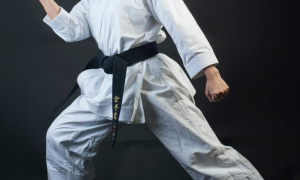
Yes, Taekwondo allows punches. Practitioners learn and practice a range of punches, including basic ones like jabs, straight punches, and uppercuts, as well as more specialized strikes like hook punches and backfists. The regulations for punches differ among various Taekwondo organizations, but they hold importance in training, self-defense, and competitions.
Although Taekwondo is renowned for its emphasis on kicking techniques, it equally integrates punches as a vital element of the martial art.
Table of Contents
ToggleBasic Punches in Taekwondo
In addition to its renowned kicking techniques, Taekwondo encompasses a variety of basic punches that are fundamental to the art’s practice. While punches might not be as emphasized as kicks, they are still an essential component of a well-rounded Taekwondo skill set. Let’s explore the three basic punches commonly taught in Taekwondo along with their mechanics and applications.
1. Straight Punch (Jireugi):
The straight punch, or “jireugi,” involves using your back hand to deliver a direct and powerful blow. It’s executed by rotating your body to generate force, while the punch itself is directed straight ahead. The primary striking surface is the first two knuckles of your fist. This punch is versatile and can target both the head and body of your opponent. While it’s not the main focus of Taekwondo, the straight punch can be effective for counterattacking or creating opportunities for follow-up techniques.
2. Middle Punch (Momtong Jireugi):
The middle punch, or “momtong jireugi,” is a straight punch aimed at the body’s midsection. It’s an efficient technique for targeting your opponent’s torso, especially when they’re advancing towards you. The mechanics of the middle punch are similar to the straight punch, with an emphasis on body rotation and generating power from the core. This punch can disrupt an opponent’s rhythm and be a useful tool for maintaining distance.
3. High Punch (Olgul Jireugi):
The high punch, or “olgul jireugi,” involves delivering a straight punch to your opponent’s head or face area. While head strikes are typically prohibited in certain Taekwondo organizations, the high punch is still taught for self-defense reasons and to foster a comprehensive grasp of punching techniques. Its execution is similar to that of the straight and middle punches, albeit with adjustments to the target height.
To help visualize these basic punches, here’s a table summarizing their key attributes:
| Punch Type | Mechanics | Target Area | Application |
|---|---|---|---|
| Straight Punch | Back-hand rotation, direct strike | Head and body | Counterattack, create openings |
| Middle Punch | Body rotation, midsection target | Midsection | Disrupt rhythm, maintain distance |
| High Punch | Similar mechanics, head target | Head or face | Self-defense, technique variety |
While Taekwondo primarily emphasizes kicks, these basic punches are crucial for developing a well-rounded skill set. They enhance a practitioner’s ability to adapt to various situations, counter opponents, and create opportunities for follow-up actions.
Full List of WTF and ITF Taekwondo punches
Practitioners of Taekwondo can strategically employ a well-rounded skill set by comprehending the distinct punches, their strengths, and applications, for use in various situations. Below is a comprehensive list of punches from both ITF and WTF/ATA Taekwondo, along with their strengths, weaknesses, and key applications.
| Punch | Description | Strengths | Weaknesses | Applications |
|---|---|---|---|---|
| Jab | Quick and straight punch used for distance measurement. | Fast execution, used for range control. | Limited power due to lack of body rotation. | Measure opponent’s distance, set up kicks, baiting the opponent. |
| Straight Punch | Back-hand punch with body rotation for power. | Generates power, effective for close quarters. | Limited range compared to kicks. | Counterattacks, strikes when opponent is advancing. |
| Uppercut | Upward punch delivered from lower stance. | Good for close combat, targets body. | Limited range and telegraphed motion. | Rip body shots, break opponent’s guard. |
| Hook Punch | Short and compact punch to the sides of an opponent. | Surprising angle, targets sides. | Limited range and potential for counterattacks. | Strike around opponent’s guard, effective in close range. |
| Backfist | Strike with the back of the hand, often used as a jab. | Quick and unexpected, catches opponents off guard. | Limited power and range, vulnerable position. | Target side of the head, create openings for kicks. |
| Turn Backfist | 180-degree turn before striking with back of hand. | Adds power and rotational force. | Requires precise timing and positioning. | Create angle of attack, counter from a defensive stance. |
| Spinning Backfist | 360-degree spin followed by backfist strike. | Unpredictable, generates power from rotation. | Difficult to set up, exposes back momentarily. | Catch opponent off guard, mix up attack patterns. |
| Hammerfist | Downward strike with padded part of hand, like a hammer. | Good force from above, can bypass guard. | Limited range, leaves head exposed. | Strike downward for power, follow up with kicks. |
| Extended Knuckle Punch | Reinforced punch using extended knuckles. | Increases striking surface area. | Precise accuracy is a requirement, as it can be easily blocked. | Target weak points, create discomfort in opponent. |
| Spear Hand Strike | Open hand strike with extended fingers, resembling a spear. | Targets soft areas, such as side of neck. | Vulnerable position, limited power compared to closed fist. | Strike soft targets, disrupt opponent’s balance. |
| Ridge Hand Strike | Strike with the meaty part of hand under the thumb. | Surprising angle, can bypass guard. | Limited range, needs careful execution. | Strike sides of head, create openings for kicks. |
| Palm Strike | Strike with open hand, fingers tucked in, to chin or nose. | Quick and close-range strike. | Limited power, vulnerable to counters. | Used in self-defense, surprise opponents in close combat. |
Key Applications and Considerations:
- Tactical Variety: Understanding each punch’s strengths and weaknesses allows practitioners to strategically incorporate punches into their combinations and tactics.
- Range Control: Jabs and straight punches are effective for measuring and controlling distance, setting up opponents for kicks.
- Close Combat: Uppercuts and hook punches excel in close-quarters combat, targeting an opponent’s body and sides.
- Surprising Strikes: Backfists, turn backfists, and spinning backfists catch opponents off guard and disrupt their defense.
- Precision Strikes: Extended knuckle punches and spear hand strikes target weak points and delicate areas on the opponent’s body.
- Mixing Techniques: Combining punches with kicks creates unpredictable combinations that keep opponents guessing.
- Adaptability: Being aware of each punch’s strengths and weaknesses allows practitioners to adapt their strategy based on their opponent’s style and weaknesses.
Different Taekwondo Punching Rules Among Organizations
Several major organizations practice and regulate Taekwondo, each establishing its own set of rules and guidelines. While the emphasis on kicks is consistent across these organizations, there are notable differences in the rules regarding punches, especially in tournament settings. Let’s delve into the punching rules of three prominent Taekwondo organizations: the International Taekwondo Federation (ITF), the World Taekwondo Federation (WTF), and the American Taekwondo Association (ATA).
Here’s a comparative table highlighting the key differences in their punching rules and tournament scoring:
| Organization | Punching Rules | Allowed Target Areas | Scoring for Punches |
|---|---|---|---|
| ITF (International Taekwondo Federation) | Punches to the head and body are allowed, offering a variety of punching techniques. | Head and body | Points awarded for clean punches to both head and body. |
| WTF (World Taekwondo Federation) | Punches are limited to the body. Only straight strikes using the padded knuckle part of the hand are allowed. | Body | Points awarded for clean punches to the body |
| ATA (American Taekwondo Association) | Just like in the WTF (World Taekwondo Federation) rules, punches are confined to the body, and only straight punches are permitted. | Body | Points awarded for clean straight punches to the body |
Key Differences:
ITF (International Taekwondo Federation) Punches:
- Both head and body punches are permissible, offering a diverse array of punching techniques.
- Successful clean punches to both the head and body result in awarded points.
- The ITF’s rules encourage a broader use of punching techniques, allowing practitioners to employ various strategies during matches.
WTF (World Taekwondo Federation) Punches:
- Punches are limited to targeting the body.
- Permitted are solely straight strikes utilizing the padded knuckle section of the hand.
- Accurate punches to the body lead to the accumulation of points.
- The WTF’s rules prioritize a more controlled and specific application of punches, emphasizing accuracy.
ATA (American Taekwondo Association) Punches:
- Punches are similar to those in WTF, restricted to only the body
- Only straight punches are allowed
- Points are gained for well-executed straight punches
- The ATA’s rules align with those of WTF, emphasizing precise punches to the body.
While the emphasis on kicks remains a defining feature of Taekwondo, understanding the variations in punching rules among different organizations is essential for practitioners participating in tournaments. Depending on the organization, punches may have different target areas and restrictions, shaping the strategies and techniques used in competition.
Why Punches Are Less Common in Competitive TKD and Why Do Competitors Keep Their Hands Down?
Taekwondo tournaments typically award more points for head kicks compared to punches. This creates an incentive for competitors to hone their head-kicking techniques due to the substantial point gain. Conversely, punches offer fewer points and carry risk due to their shorter range and susceptibility to counterattacks. Athletes dedicate their efforts to perfecting kicking techniques and crafting strategies tailored around kicks.
Taekwondo Competitors Keeping Their Hands Down
The choice to lower the hands in Taekwondo competitions is a direct result of the sport’s rules, which strongly deter punches in most situations. Competitors understand that optimizing their stance for kicks offers them a competitive edge. This strategic adaptation underscores the dynamic nature of Taekwondo, where agility and skillful kicks are paramount for success.
FAQ
Can you elbow in Taekwondo?
The Taekwondo curriculum includes elbow strikes, but these strikes are not present in tournaments. The sport places a significant emphasis on kicks and punches, with kicks taking precedence. Elbow strikes are more commonly associated with other martial arts disciplines, and they are typically not allowed in standard Taekwondo tournaments.
What are you not allowed to do in Taekwondo?
In Taekwondo tournaments, there are specific rules and regulations in place to ensure the safety of competitors and maintain a level playing field. Taekwondo competitions generally prohibit the following actions:
- Elbow and knee strikes: Traditional Taekwondo does not emphasize the use of elbow and knee strikes, and they are not typically allowed in tournaments.
- Targeting prohibited areas: Strikes to the groin, throat, or back of the head are considered illegal due to their potential for serious injury.
- Excessive contact or unsportsmanlike behavior: Competitors are expected to display respect and sportsmanship during matches. Excessive force, unsportsmanlike conduct, or intentional fouls are penalized.
- Ineffective techniques: Strikes that lack proper control, form, or precision may not be awarded points by judges.


